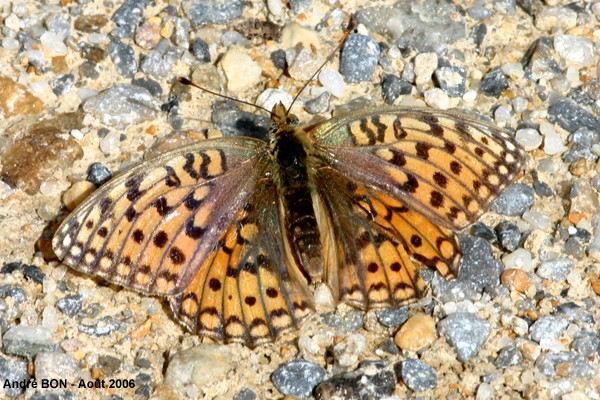
| Pearl-bordered Fritillary (Boloria euphrosyne (Linnaeus, 1775)) |

|
|
Scientific name: Boloria euphrosyne (Linnaeus, 1775) Common name: Pearl-bordered Fritillary French name: Grand Collier argenté Order: Lepidoptera Suborder: Rhopalocera Family: Nymphalidae Subfamily: Heliconiinae Wingspan: 38-46 mm. Biotope: Meadows and woodlands up to 1800m. Geographic area: Europe (missing in south of Spain), temperate Asia as far as the Amour river to the East. Flight time: April-June then August-September. Number of generations : 2 (1 in the north). Caterpillar: Black and grey, mottled with white, with yellow spines. Host plant: Violet (Viola sp.) |
The Pearl-bordered Fritillary has, like the similar species, Small Pearl-bordered Fritillary (Boloria selene), one black spot near the base of the hindwings. This basal spot can be seen on the upperside and on the underside of the butterfly. You can differentiate both species by observing the underside of the hindwing. Euphrosyne is a more pinkish/brown/red colour, yellow and red marks are sharper on selene. The basal spot is larger on selene. This spot is small, round and circled with yellow on euphrosyne. The white marks near the outer border are bordered with black on selene. The central white mark looks larger and bolder on euphrosyne. To be confirmed: The black round spots on the upper side of the forewing are more distant from the edge on euphrosyne than on selene. The Pearl-bordered Fritillary overwinters as a caterpillar. |
| [To know more about the Pearl-bordered Fritillary] [Top] |

|
You can clearly see the black basal spot on the hindwing. There is a possible confusion with Boloria selene (Small Pearl-bordered Fritillary). A view from the underside of the hindwing is needed to validate which species is observed. I have based the identification on the wingspan which is slightly larger than the wingspan of Small Pearl-bordered Fritillaries I have observed in the surroundings. I have also based the identification on the distance between the black round spots the edge of the wing. I will replace this picture as soon as I have one with a higher confidence in the identification of the species. |